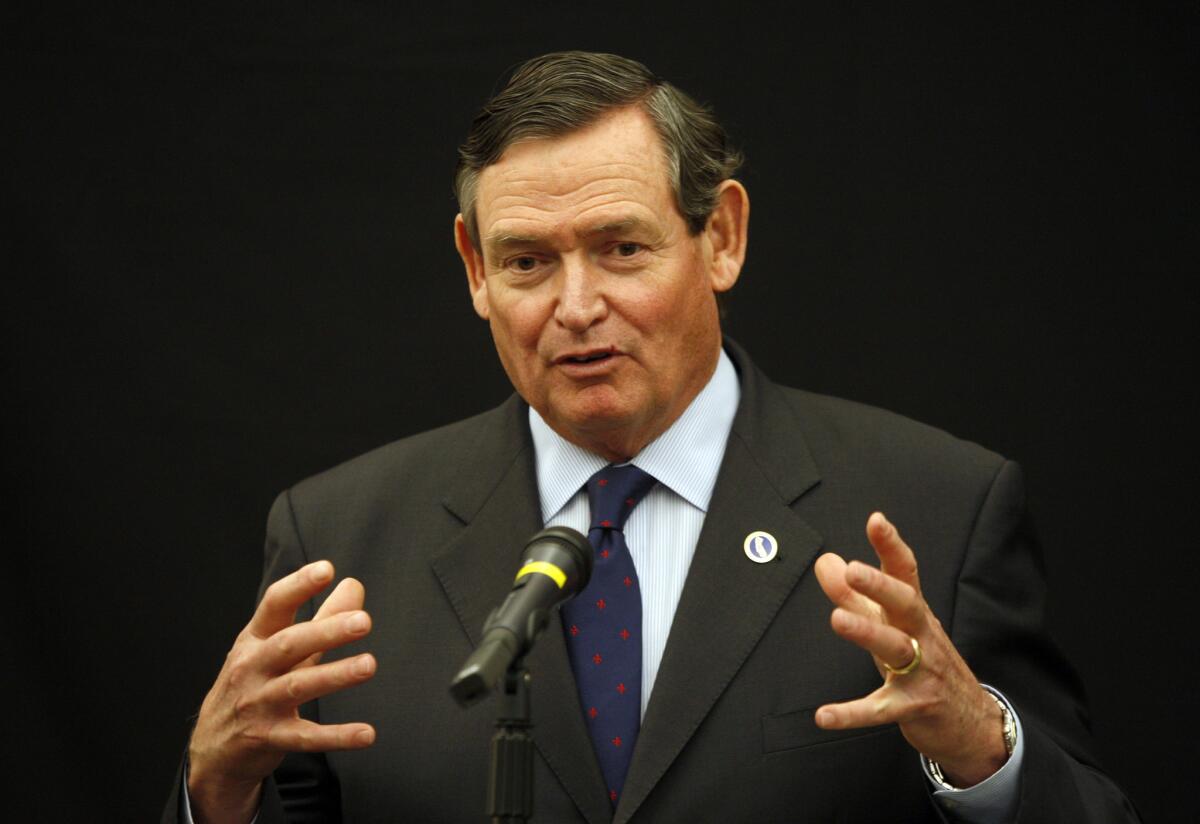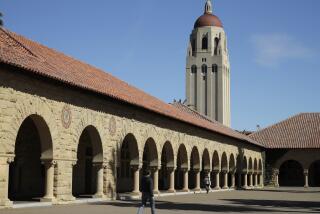Cal State trustees to review cost-cutting measures at Long Beach meeting

The 23 campuses of the California State University system are sharing more resources, from combining financial systems to coordinating the purchase of electronic library materials in an effort to reduce costs and maximize all available services.
How those cost savings factor into closing an anticipated $97-million state funding shortfall will be under review in a presentation to the Board of Trustees, meeting in Long Beach on Tuesday and Wednesday.
In November, trustees approved a 2015-16 budget request of $269 million, including $216.6 in new state funding. Gov. Jerry Brown has proposed an additional $119.5 million for both Cal State and the University of California.
If Brown’s plan prevails, the system would be able to enroll only an additional 3,500 students next fall, turning away thousands more who are eligible, officials said.
That is why Chancellor Timothy P. White has initiated an aggressive cost-cutting initiative that includes greater coordination among regional campuses from Humboldt to San Diego.
Cal State is also working more closely with UC and community college campuses on energy saving and purchasing partnerships, and trustees will get an update on those efforts.
“We are operating at a time when we’re obviously receiving less funding from the state than prior to the recession and we’re having to do more with less,” said spokesman Mike Uhlenkamp. “For every dollar we can save in terms of efficiency we’re able to divert that to some of those mission critical elements such as access for students and improving educational quality.”
Unlike UC President Janet Napolitano, White has resisted calling for a general tuition increase. But other revenue generating ideas — such as charging higher tuition to those who’ve amassed more credits than needed to graduate — are under consideration.
As Cal State looks for more resources, faculty complain that they have been on the short end of investment, with staffing and salaries comparing poorly to that of administrators, according to a report released Tuesday by the California Faculty Assn.
The union represents about 25,000 Cal State professors, lecturers, librarians, counselors and coaches.
The report, “Race to the Bottom: Salary, Staffing Priorities and the CSU’s 1%,” culled CSU payroll and budget data, finding that over the last decade the number of managers and supervisors system-wide grew by 19% while the number of tenured and tenure-track faculty fell by 3%.
Reduction in permanent faculty occurred even as the student population increased by 24% during that time, according to the report.
“Instead of investing in permanent faculty, CSU administrators have adopted a fast-food franchise model of faculty staffing for the university’s core mission,” the report said.
In addition, while salaries for full-time faculty increased by 10% from 2004 to 2014, those for managers and supervisors increased by 24%, according to the report. In 2014, the average salary for a manager/supervisor, excluding campus presidents, was $106,149 compared with a full-time faculty salary of $64,479.
In November, trustees approved a 3% pay hike for top executives, including White and the 23 campus presidents, who had not received boosts in seven years.
Cal State previously had been heavily criticized for hiking pay for newly hired presidents in the midst of the recession and while boosting tuition. White has tried to chart a different course, for example, seeking a 10% reduction in the state-funded portion of his salary when he was hired in 2012.
After going five years without a raise, faculty won a 1.34% pay increase in 2013 and a 1.6% boost last year. The latest three-year pact called for the two sides to reopen salary and benefit talks for 2015-16 and 2016-17.
“I don’t think that CSU disbelieves that there is a problem, but we’re trying to say, what does this problem look like, how does it compare to other things going on in the system and how does this problem affect faculty and students,” said faculty association President Lillian Taiz, who will discuss some of the findings at the board meeting. “Our hope is that it starts a conversation about how to bring about meaningful change and not have symbolic gestures.”
Cal State officials said White is committed to improving faculty hiring and compensation. The system hired about 740 full-time faculty last year, although some of those gains were offset by retirements, union officials contend.
And nearly $130 million has been set aside for employee compensation in the last two years, with $65 million more set aside in the 2015-16 budget, said spokeswoman Laurie Weidner.
“As soon as the state began to reinvest in the CSU we prioritized improving employee compensation,” Weidner said. “Our dedicated faculty deserve it, and our mission of serving students requires it.”
Trustees, meanwhile, were also scheduled to receive updates on initiatives to improve graduation rates and better prepare new students for college-level English and math and to approve several new degree programs.
In addition, trustees were scheduled to interview finalists to replace outgoing Sacramento State University President Alexander Gonzalez and may announce a successor Wednesday, officials said.
Gonzalez previously announced his intention to retire at the end of the 2014-15 academic year after leading the Sacramento campus for 11 years.
Twitter: @CarlaRiveraLat
More to Read
Start your day right
Sign up for Essential California for news, features and recommendations from the L.A. Times and beyond in your inbox six days a week.
You may occasionally receive promotional content from the Los Angeles Times.







